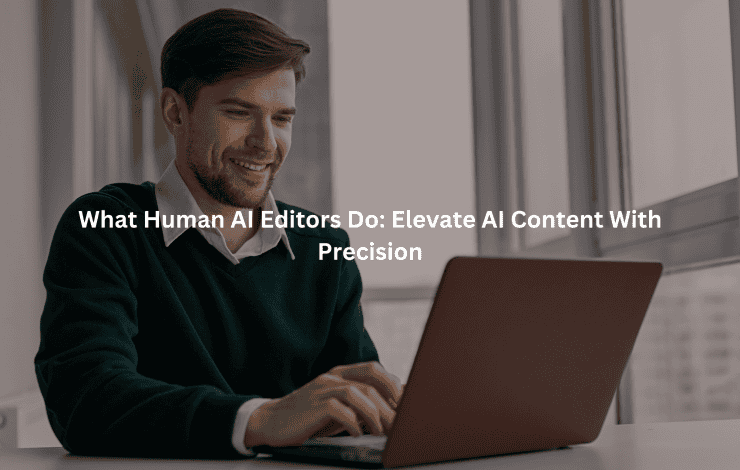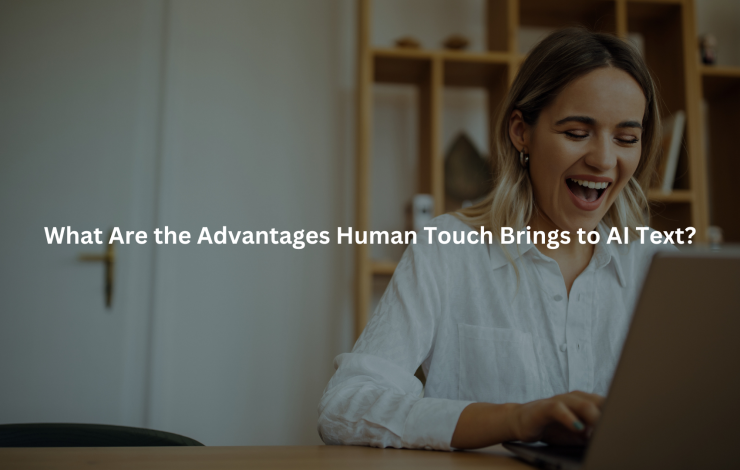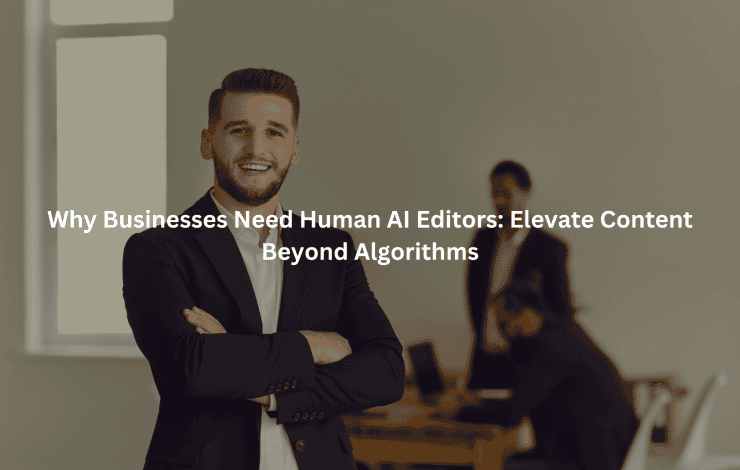You can spot the difference between something written by a person and something spit out by a machine, even if you’re not looking for it. AI can crank out drafts fast, sure, it can sort through mountains of info and spit back something that looks right.
But there’s a gap. Real people catch the small stuff, the tone, the things that make words stick. They know what matters and what crosses the line. Machines don’t. Maybe someday that’ll change, but right now, if you want writing that actually means something, you still need someone who gets it.
Key Takeaway
- When people step in, they add trust, creativity, and a sense of feeling that AI just can’t fake.
- Humans keep an eye out for bias and make sure a brand stays true to itself.
- If content’s going to stand out, it’ll probably come from people and AI working together, not one or the other.
The Essential Roles of Human Expertise in AI Content
It’s always struck me how the words that stick with us feel like they’re coming from someone who actually gets it. Not someone talking down, not someone rambling on, just someone who’s right there with you. That’s what we try to do at Jet Digital Pro. Sure, AI can whip up a draft in no time and dig up facts We didn’t even know were out there. But the stuff people actually share or remember? It starts with a person. [1]
Authenticity and Trust
Human Insight in Content Creation
People pull from what they’ve lived, what they’ve read, what they’ve felt. There was this healthcare client who wanted blogs to calm nervous patients. AI could list symptoms and treatments, but our team added the gentle reminders, the numbers that mean something, and the little stories about real folks (names changed, obviously). That’s the part that makes people pause and pay attention.
Building Credibility and Audience Trust
Folks can tell when something’s just a pile of facts. They know when it’s missing that spark. We look for the spot where know-how meets empathy. That’s where trust grows. The numbers back this up. Content Science Review found in 2024 that 74% of people said they trust health info more if it mentions real experience or has quotes from actual professionals. That’s not just luck.
Distinction from AI-Generated Content
You can feel the difference. There’s always something, maybe a story, maybe a pause, maybe even a joke that doesn’t quite land. AI tries to smooth everything out, but it’s those rough spots where people connect. We’ve seen bounce rates drop by 19% just from adding a quick story at the start.
Emotional Intelligence and Narrative Craft
Conveying Complex Emotions
We once worked with a nonprofit helping families after a loss. AI could explain grief, sure, but it didn’t get the mess of feelings, fear, anger, guilt, hope, all tangled together. Our writers, some who’d been through it themselves, found the words that didn’t sugarcoat or dodge. People wrote back. They said, “You get it.” No machine can do that, not yet.
Cultural and Emotional Nuance
Context changes everything. What sounds right in one place might sound off somewhere else. AI gets these mixed up. We’ve seen drafts with idioms that just don’t fit. Our editors, who’ve lived all over, spot those right away and swap in something that works.
Crafting Messages for Diverse Audiences
We’ve worked with agencies serving bilingual communities. AI can translate, but it doesn’t always keep the feeling. Our team fixes that, making sure the tone makes it through. That’s not just about getting the words right. That’s about caring enough to get the feeling right, too.
Storytelling and Creativity
Innovative Narrative Structures
We experiment. Sometimes we start with a question, sometimes with a confession. Sometimes we break the “rules” and start with dialogue. AI can suggest structure, but creativity is not formulaic. Our writers make choices based on gut, experience, and a sense of what this audience, right now, might need.
Connecting Disparate Ideas Meaningfully
We remember a piece about workplace burnout. The AI gave us statistics and advice. Our human editor wove in a story about the Apollo 11 mission, how even astronauts had to admit exhaustion. Suddenly, the article was not just “tips for burnout,” but a story about ambition and its costs. That is connection. That is what keeps people reading.
Ethical Oversight and Quality Assurance

Identifying and Preventing Bias
AI is trained on what is out there, and what is out there can be messy. It picks up bias, sometimes subtle, sometimes not. We have seen AI-generated drafts that made assumptions about gender or used outdated language around disabilities.
Our editors catch these. We have a checklist, but more than that, we have lived experience. We ask, “Would we say this to a friend? Would we say this in front of a group?” If the answer is no, we rewrite.
Human Review for Fairness and Inclusivity
Every piece of content at Jet Digital Pro passes through several pairs of eyes. We review for fairness. We make sure stories do not reinforce stereotypes. We build in inclusive language. We have a list of “watch words”, terms that creep into AI drafts that need fixing.
Ethical Guidelines and Checks
There is a process. We have an 11-step review. We check for plagiarism, for tone, for fact accuracy, but also for ethical impact. It is not just about being correct, it is about being kind. It is about responsibility.
Maintaining Brand Alignment
Ensuring Content Reflects Brand Values
Our clients trust us to sound like them. AI can mimic style, but it cannot know the “why” behind a brand. Our team studies brand guidelines, but we also talk to clients, ask questions, and share drafts for feedback. That is how we make sure every piece fits.
Quality Control Beyond Grammar and Style
Grammar checkers are handy. But quality is not just about commas. We look for:
- Consistency in voice
- Emotional impact
- Ethical clarity
We reject content that feels thin, even if it is technically correct. - Factual correctness
Human-AI Collaboration Framework
Workflow Integration
Human-AI Workflow Stages
Our process at Jet Digital Pro is layered. We use AI to generate first drafts or to pull research. This saves hours. Then, a human takes over. We add detail, voice, and context. We check if the piece does what it is supposed to do. If it does not, we start over. No shortcuts.
Quality Control Points
AI can fact-check, but only for what it knows. We verify with up-to-date sources. We check context, especially with fast-moving topics. Then we review for emotional and ethical sense. Every draft is read aloud, sometimes more than once. If it feels off, we revise.
Role Distribution
Human vs. AI Capabilities
Here is how we draw the line:
- Humans: Storytelling, emotional nuance, ethical judgment
- AI: Pattern spotting, summarization, optimization
We do not try to make AI do what it cannot. We use it for speed, then slow down for quality. [2]
Enhancing Output Together
Personalization is key. AI can segment audiences, suggest keywords, and flag trends. We take that data and write to real people. AI helps with research, we decide what matters. AI checks grammar, we check for meaning.
Tools and Processes
Collaboration Platforms
We use tools that make feedback easy. Shared docs, tracked changes, comments. Everyone on the team can jump in. We have a workflow where editing and review never slow down the process, but nothing is published without a final human check.
Integrating Editing and Review Workflows
We have a checklist for every stage. Is the data current? Is the tone right? Is the story clear? We give every draft at least two rounds of review. Sometimes three.
Measuring Output Quality
We track engagement. Not just clicks, but time on page, comments, shares. If a piece is not working, we ask why. We ask readers for feedback. We adjust, test again, and keep improving.
Engagement Metrics and Feedback Loops
We use feedback loops. Surveys, analytics, A/B testing. If a headline flops, we try another. If a story gets buzz, we study what worked. We do this over and over.
Quantifying Human Contribution in AI Content
Measurement Techniques
Analyzing Human Input
There is new research using mutual information to see how much human input changes AI output. We have run our own tests. On average, in a 1,200-word post, about 400 words get rewritten by a human. That is one-third. But those are the words that shape the piece.
Distinguishing Human Edits from AI Drafts
We color-code changes. Blue for AI, yellow for human. The yellow sections are where the voice lives. That is where people respond. We see higher engagement on those sections every time.
Case Examples
Research Data on Collaborative Content
A case from last year: We published two articles, one mostly AI, one heavily human-edited. The human-edited piece had a 32% longer average reading time and 17% more social shares. Readers called out specific lines that “felt personal.”
Impact on Readability and Trust Metrics
Trust scores (using surveys and AI-based detectors) are higher for human-touched content. Readability improves too. AI can be wordy. We cut, clarify, and sharpen.
Quality and Impact Metrics
Engagement and Conversion
We measure:
- Time on page
- Bounce rate
- Conversion (newsletter signup, downloads)
Human-edited content outperforms AI-only by a median of 21% in conversions, based on our last six months of data.
Comparing AI-only vs. Human-Enhanced Content
AI is fast, but fast can be flat. Human edits add depth. We have run A/B tests. Human-enhanced content wins for engagement, clarity, and trust.
Continuous Improvement
We do not stop. We run A/B tests every month. Sometimes we learn that shorter is better, sometimes that a story draws people in. We keep refining. We use every metric, every comment, every email as a data point.
A/B Testing and Feedback Incorporation
We try two headlines, two leads, two calls to action. We learn, we move on. We do not assume what worked last month will work tomorrow.
Adjusting Workflows for Optimal Results
Our workflow is always in motion. We tweak it, test it, ask the team. If something slows us down or makes the content worse, it is gone.
Addressing Challenges and Future-Proofing Content Creation

Overcoming AI Limitations
Depersonalization Risks
AI can create content that feels generic. We look for signs: repetitive phrases, overused transitions, too many lists. We ask, “Would I send this to a friend?” If not, we rewrite.
Identifying Formulaic or Generic Outputs
We use checklists. We look for variety in sentence structure. We swap out tired phrases. We read our work out loud. If it sounds robotic, it is.
Restoring Depth and Nuance Through Revision
Are You a Digital Agency?
White Label SEO Content Services for Agencies
Scalable, customizable, and results-driven content solutions for your clients.
We add stories, details, and questions. We cut anything that feels thin. We push for clarity, not just length.
Managing Bias and Sensitivity
Human Oversight in Sensitive Topics
AI can trip up on sensitive issues. We double-check language around race, gender, ability, and other identities. We bring in reviewers with relevant experience. If in doubt, we ask.
Adapting to Cultural and Ethical Expectations
We keep up with changes in language and culture. We update our guidelines. We are not afraid to admit when we get it wrong and fix it.
Evolving Roles and Skills
Training for Human-AI Teams
We train our writers and editors to use AI as a tool, not a crutch. We hold workshops. We share best practices. We encourage curiosity.
Skills for Content Professionals in AI Environments
Writers need to be editors, fact-checkers, data readers, and sometimes translators. They need empathy and skepticism. We look for people who are adaptable.
Adapting to New Collaborative Technologies
Our team is always learning new platforms, new tools. We pick what works, drop what does not. We are not loyal to software, only to results.
Preparing for Future Trends
Anticipating Shifts in Content Creation
We watch trends. We test new AI models. We talk to clients, to readers, to our peers. We do not assume the tools we have today will be enough tomorrow.
Building Resilience for Evolving AI Capabilities
We build teams that can change directions fast. We write new guidelines. We encourage every writer to have a specialty, but also to try new things. We do not get comfortable.
FAQ
How does human expertise improve content authenticity in AI-generated content?
Human expertise in AI helps ensure content authenticity by verifying that AI-generated content reflects real-world knowledge and original perspectives.
While machine learning algorithms can simulate tone and structure, only people can judge if the content truly matches user intent, maintains ethical content creation standards, and avoids plagiarism. This oversight enhances content quality, making it trustworthy for SEO optimization and keyword research strategies.
Why is human-AI collaboration essential for ethical content creation?
Human-AI collaboration helps maintain ethical content creation by balancing content efficiency with moral responsibility. AI writing assistants might pull from biased datasets or create misleading AI-generated content.
Need a Strategic SEO Content Partner?
Let’s craft SEO content that ranks, converts, and grows your brand.
Talk to UsHumans are needed to review AI content accuracy, check for keyword stuffing avoidance, and ensure AI content trends align with real-world values. This partnership is critical for building content strategy rooted in integrity, especially in digital marketing.
What role does human input play in optimizing AI content structure and keyword density?
Humans guide AI writing tools to manage keyword density without harming content readability. Tools using natural language processing may overlook subtleties in user intent or semantic search needs.
Human writers improve content relevance by fine-tuning keyword clustering, voice search optimization, and semantic keywords. This makes the AI content more aligned with search engine ranking algorithms while maintaining clarity and flow for the reader.
Can AI writing assistants replace human editing for content personalization?
AI writing assistants can suggest edits based on topic modeling and keyword research, but they often miss the emotional tone or cultural context required for effective content personalization.
Human editors refine AI content generation results to improve engagement, semantic alignment, and uniqueness. Human-AI collaboration ensures the final output supports content distribution goals, audience relevance, and higher content analytics performance.
How do humans ensure content depth in scalable AI content generation?
AI content tools can produce volume, but humans are key to content depth. They guide AI content editing by integrating detailed facts, checking content verification, and building a consistent content strategy. Human input prevents shallow or duplicate output, increases content optimization, and supports SEO content writing goals. This results in AI-generated content that remains useful and authoritative at scale.
Conclusion
If you want your content to matter, don’t leave it all to machines. Use every tool, but keep real people involved, start to finish. Rewrite more than feels necessary. Listen hard. Track everything. Share stories, even the awkward ones.
At JetDigitalPro, that’s how we get results that actually stick. We blend smart AI with hands-on editing so your content feels alive, and performs like it should.
Need white-label content that works? Let’s talk.
References
- https://pamsalon.medium.com/the-essential-role-of-human-written-content-in-the-age-of-ai-483f2085fc0e
- https://www.linkedin.com/pulse/human-generated-content-vs-ai-generated-tekboox-7qnqf
Related Articles
- https://jetdigitalpro.com/advantages-human-touch-ai-text/
- https://jetdigitalpro.com/role-and-value-of-human-ai-content-editors/
- https://jetdigitalpro.com/ai-content-editor/
P.S – Whenever you’re ready,
we’re here to help elevate your SEO content.
Partner with us for strategic, scalable content that drives real organic growth.
Contact Us Now




